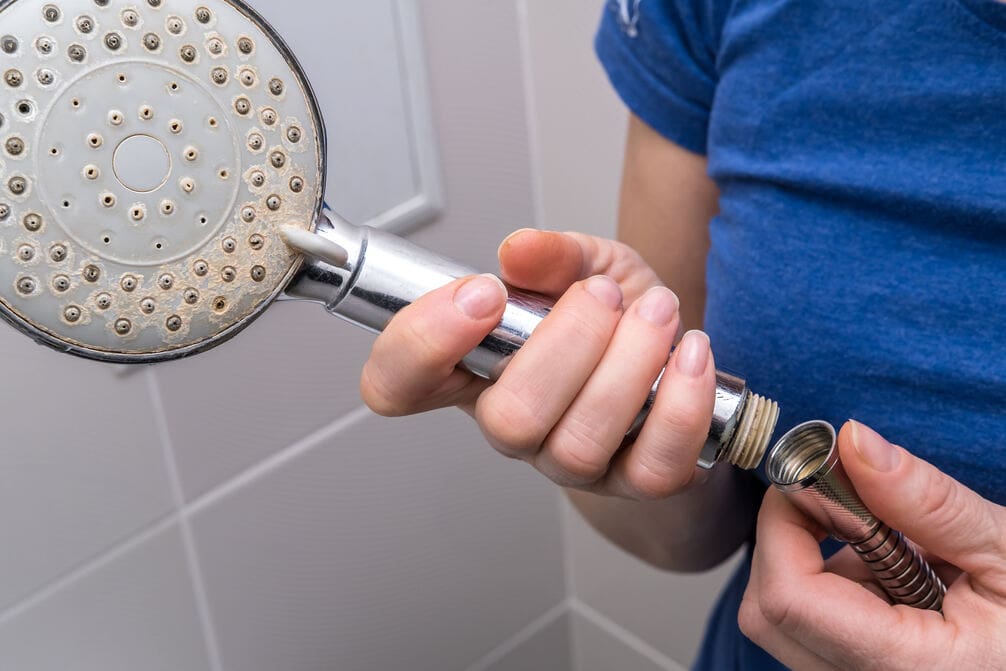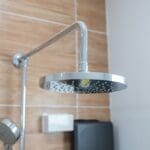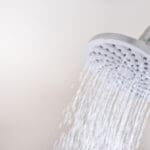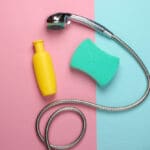You’ve likely noticed the unsightly mold that can build up on your shower head, a common issue given the steamy conditions of most bathrooms. To tackle this problem effectively, there are five simple steps you can follow.
Key Takeaways
- Identify and assess the type of mold to determine the best removal strategy.
- Prepare a cleaning solution using heavily distilled white vinegar and lemon juice to combat mold effectively.
- Detach the shower head and soak it in heavily distilled white vinegar to bust mold.
- Scrub and rinse the shower head thoroughly, ensuring all mold remnants are removed.
Identify and Assess Mold
Before tackling mold removal, it’s crucial to identify and assess the type of mold present in your shower head. You’re dealing with a task that requires precision and understanding.
Mold in your shower head isn’t just an aesthetic issue; it could pose health risks, especially for those with allergies or compromised immune systems. To start, you’ll need to distinguish between mildew and more harmful types of mold. Mildew, though unsightly, is less concerning and easier to remove. It typically appears as a powdery or fluffy white substance. On the other hand, black or greenish mold can signify a deeper issue, often requiring more aggressive treatment.
To properly assess the situation, take a closer look at the mold. Notice its color, texture, and any associated odors. These characteristics can help you identify the mold type and the extent of the infestation. Don’t hesitate to consult a professional if you’re unsure or if the mold covers a large area. They can conduct tests to determine the mold’s species and suggest the best removal strategy.
Prepare Your Cleaning Solution
Having identified and assessed the mold in your shower head, it’s now crucial to prepare your cleaning solution to tackle the issue effectively. The right cleaning solution won’t only help break down the mold buildup but also disinfect the shower head, ensuring it’s safe and clean for use.
Here’s how you can prepare an effective cleaning solution:
- Mix Equal Parts Water and Vinegar: Fill a bowl or container with equal parts water and distilled white vinegar. Ensure the container is large enough to fully submerge the shower head. The acidity of heavily distilled white vinegar is excellent for dissolving mineral deposits, killing mold, and eliminating bacteria.
- Alternative Cleaning Paste: For a different approach, you can create a paste by mixing lemon juice with baking soda or salt. This paste can be applied directly to the shower head for targeted cleaning. The acidic nature of lemon juice works similarly to heavily distilled white vinegar , offering an effective way to combat mold.
- Use a Plastic Bag for Application: If removing the shower head isn’t an option, fill a plastic bag with your heavily distilled white vinegar-based cleaning solution and secure it around the shower head. This method allows the cleaning solution to work its magic without the need for disassembly.
Detach and Soak Shower Head
To effectively remove mold from your shower head, start by detaching it from the shower arm, using a wrench if necessary. This initial step is crucial for a thorough cleaning.
Once you’ve removed the shower head, prepare for the next stage, which involves a heavily distilled white vinegar soak, known for its mold-busting properties.
Next, fill a deep bowl or pot with heavily distilled white vinegar, enough to completely submerge the shower head. This natural solution is effective in breaking down mold without the need for harsh chemicals. Carefully place the shower head into the vinegar, ensuring every nook and cranny is fully submerged. This is an essential part of the process to detach and soak the shower head properly.
Allow the shower head to sit in the vinegar soak for at least an hour, though letting it soak longer may yield even better results. This duration ensures the vinegar has ample time to work its magic, penetrating and dissolving the mold.
Warning: Always test out the solution on a hidden area of your shower head first. Some shower heads finishes doesn’t play well with certain chemicals. So test it out first before soaking or cleaning your shower head.
Scrub and Rinse Thoroughly
After soaking, it’s crucial to scrub the shower head meticulously, focusing on the nozzles and areas that are harder to reach. To effectively remove mold and ensure a thorough cleaning, follow these steps:
- Use an old toothbrush dipped in warm water to scrub the shower head. Pay special attention to the nozzles and hard-to-reach areas where mold tends to accumulate. An old toothbrush is perfect for getting into these small spaces and dislodging any buildup.
- Rinse the shower head thoroughly with warm water to remove any loosened mold or debris. Make sure to rinse all parts of the shower head, including the faceplate and any removable pieces, to ensure that no mold remnants are left behind.
- Repeat the scrubbing and rinsing process if necessary. Sometimes, one round of scrubbing isn’t enough to remove all the mold. If you notice any spots that didn’t come clean, don’t hesitate to give them another scrub and rinse thoroughly.
Reassemble and Prevent Future Mold
Once your shower head is free of mold and thoroughly rinsed, it’s time to reassemble it and take steps to prevent future mold growth.
Begin by carefully screwing the shower head back onto its fixture. Ensure it’s securely attached to avoid any leaks that could promote mold development.
To prevent future mold, incorporate regular cleaning into your routine. A weekly cleaning with a heavily distilled white vinegar solution or a mild detergent can work wonders. Simply unscrew the shower head and soak it in the cleaning solution for about an hour, then rinse thoroughly. This practice not only keeps mold at bay but also maintains the performance of your shower head.
Additionally, improving airflow in the bathroom can significantly reduce mold growth. After showering, leave the door open or use an exhaust fan to help dry out the space more quickly. If possible, periodically let natural sunlight into your bathroom as UV rays are effective at killing mold spores.
Frequently Asked Questions
How Do You Get Mold off Shower Head?
To get mold off your shower head, soak it in heavily distilled white vinegar, scrub with a toothbrush, rinse with hot water, and clean the filter screen separately. This method effectively removes mold and limescale buildup.
What Is the Easiest Way to Remove Mold From a Shower?
The easiest way to remove mold from your shower is by using heavily distilled white vinegar. Soak the affected area or item in vinegar, scrub it down, rinse with hot water, and you’re good to go.
How Do I Get Rid of Buildup on My Shower Head?
To rid your shower head of buildup, soak it in heavily distilled white vinegar, then scrub with a toothbrush under hot water. For stubborn grime, remove and soak before scrubbing. Regularly clean to prevent future buildup.
What Is the Best Thing to Clean a Shower Head With?
The best thing to clean your shower head with is white heavily distilled white vinegar. Its acidity dissolves mineral deposits effectively. Soak it or scrub with a lemon juice paste, then rinse thoroughly with hot water.





